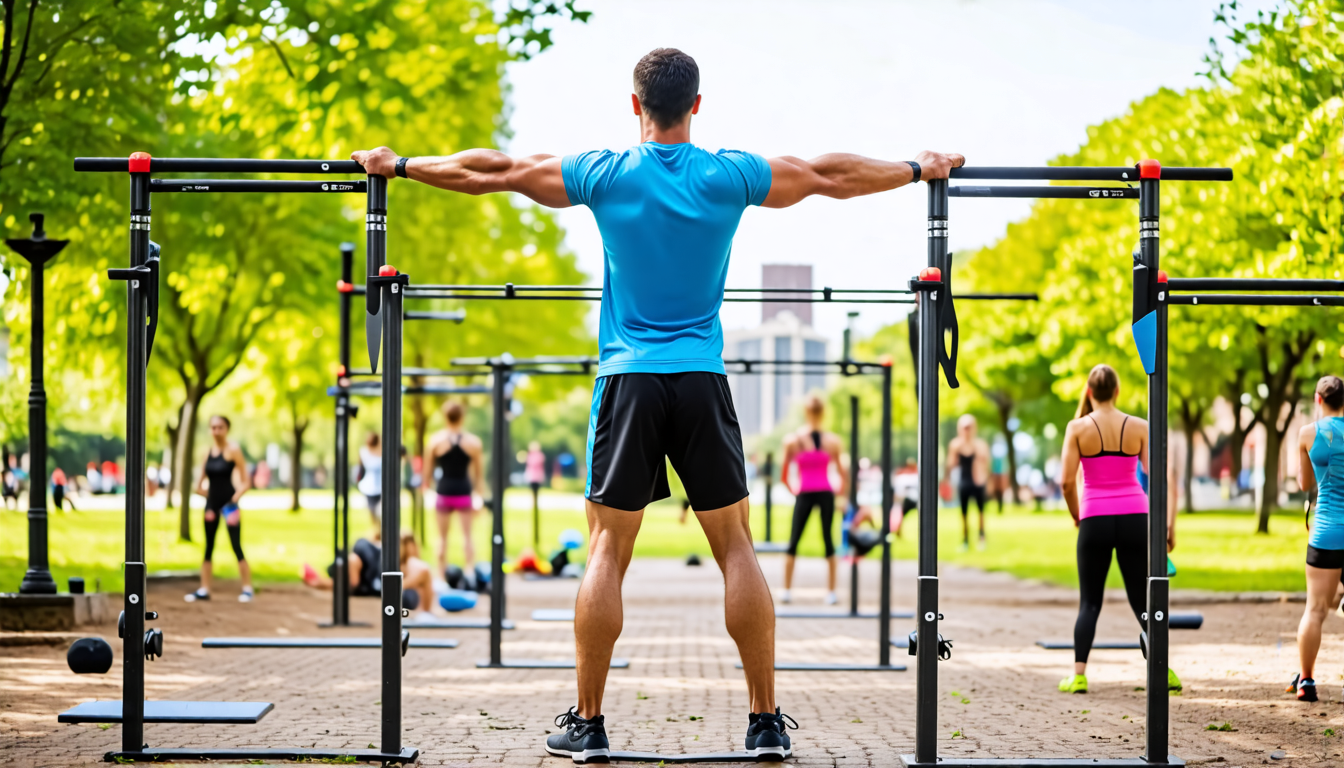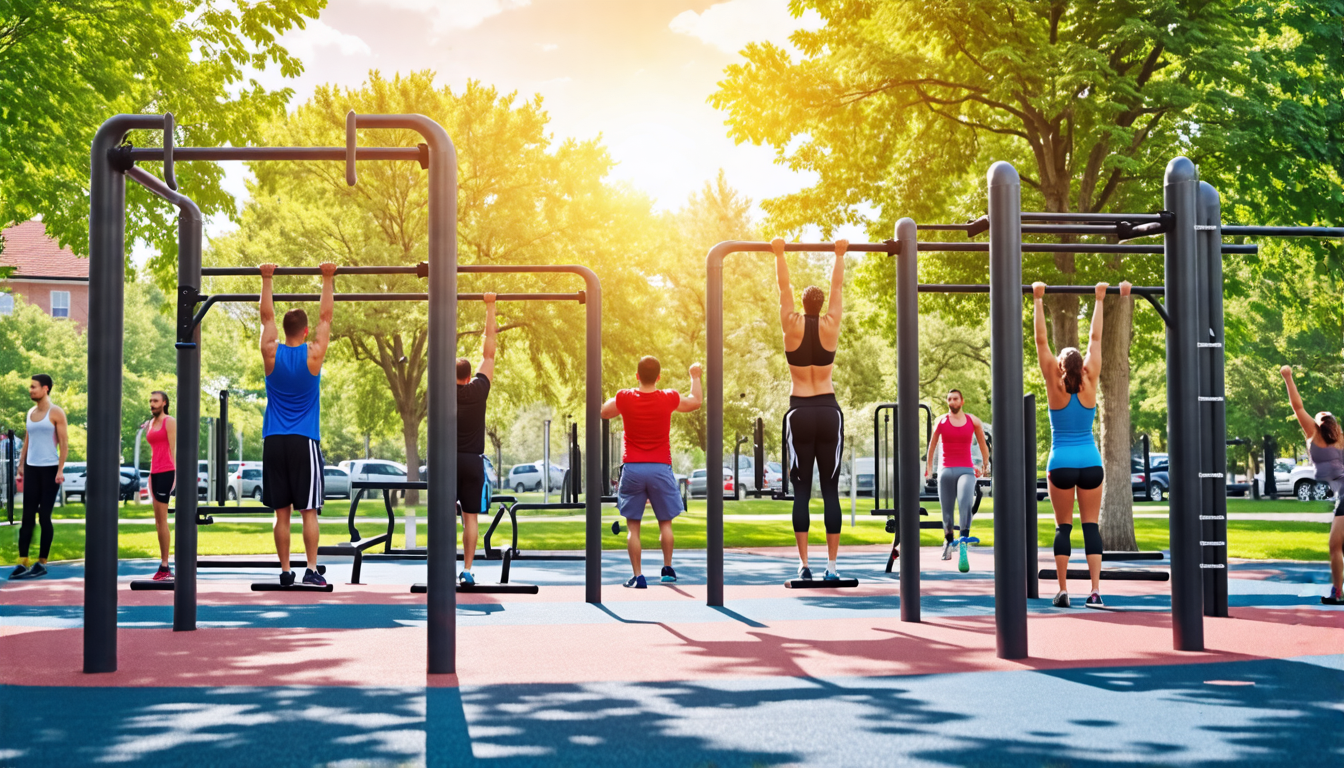Fitness bars have surged in popularity among home fitness enthusiasts, revolutionizing how calisthenics practitioners approach their workouts. In essence, fitness bars are sturdy, versatile equipment designed to support various bodyweight exercises. They come in different forms, each tailored to specific movements, such as pull-up bars, dip bars, and parallel bars. These tools have become essential for those looking to build strength, flexibility, and muscle endurance without the need for bulky gym equipment.
Incorporating fitness bars into your calisthenics routine can significantly elevate the quality and effectiveness of your workouts. By mastering fundamental exercises like pull-ups, dips, and leg raises, you lay a solid foundation for more advanced movements such as muscle-ups, front levers, and planches. The versatility of fitness bars ensures that both beginners and advanced athletes can benefit, providing a scalable challenge that grows with your increasing strength and skill level.
Moreover, fitness bars offer a practical solution for home gyms, allowing you to engage in a comprehensive calisthenics regimen without leaving the comfort of your home. With proper installation and usage, these bars can transform any space into a potent training ground, fostering a consistent and effective workout routine. Whether your goal is to enhance your athletic performance or to simply stay fit, understanding how to utilize fitness bars can be a game-changer in your calisthenics journey.
Understanding Fitness Bars and Their Role in Calisthenics
Introduction to Fitness Bars: What Are They?
Fitness bars are versatile pieces of exercise equipment designed to support a wide range of bodyweight exercises, making them a staple in calisthenics training and home fitness setups. These bars can be mounted on walls, doorways, or used as freestanding structures. Their primary function is to facilitate various forms of resistance training, particularly exercises that utilize one’s own body weight to build strength, agility, and endurance. In the context of home fitness, fitness bars provide an accessible and affordable solution for those looking to achieve their fitness goals without the need for a gym membership.
Different Types of Fitness Bars Used in Calisthenics
Pull-Up Bars
Pull-up bars are one of the most common fitness bars found in calisthenics training. These bars are designed specifically for exercises like pull-ups and chin-ups, which target the upper body muscles, including the lats, biceps, and shoulders. Pull-up bars can be installed in doorways, mounted on walls, or even fixed within power racks. They come in various designs, such as straight bars, multi-grip bars, and those with ergonomic grips, each offering different benefits and challenges.
Dip Bars
Dip bars, also known as parallel bars, are essential for performing dips, a fundamental calisthenics exercise that targets the triceps, chest, and shoulders. These bars can be found in dip stations, often featuring a stable base and padded grips for comfort. Some pull-up bars now come with optional attachments that convert them into dip bars, providing more versatility for home fitness enthusiasts. Portable dip bars are also available, making them convenient for users with limited space.
Parallel Bars
Parallel bars are an integral part of advanced calisthenics training. These bars run parallel to each other and can be used for a variety of exercises, including walking dips, l-sits, and plank exercises. They are particularly beneficial for developing core strength and control. Whether freestanding or part of a larger calisthenics station, parallel bars offer endless possibilities for both basic and complex movements, making them invaluable for any serious calisthenics practitioner.
Benefits of Using Fitness Bars for Calisthenics Training
Fitness bars offer numerous benefits that make them ideal for calisthenics training, especially in home gym setups.
Versatility: Fitness bars can be used for a wide range of exercises targeting various muscle groups. This versatility means you can achieve a full-body workout using just a few pieces of equipment.
Space Efficiency: Many fitness bars are designed to be compact and easily stored, making them perfect for home fitness enthusiasts with limited space. Doorway pull-up bars, for example, can be quickly assembled and disassembled without the need for permanent installation.
Cost-Effectiveness: Investing in fitness bars is relatively affordable compared to the overall cost of a gym membership or a full home gym setup. These bars can provide a comparable level of workout intensity and variety without breaking the bank.
Functional Strength: Calisthenics training with fitness bars emphasizes functional strength, which is the ability to use your muscles effectively in real-life scenarios. Exercises like pull-ups, dips, and muscle-ups require coordination, stability, and control, contributing to overall physical fitness and everyday performance.
Progressive Overload: Fitness bars allow for progressive overload, a principle essential for muscle growth and strength gains. By gradually increasing the difficulty of your exercises (e.g., moving from basic pull-ups to weighted pull-ups), you can continuously challenge your muscles and facilitate growth.
Joint Health: Bodyweight exercises performed on fitness bars are generally low-impact, reducing the risk of joint injuries. This makes them suitable for individuals of all fitness levels, from beginners to seasoned athletes.
Improved Grip Strength: Regular use of fitness bars enhances grip strength, which is crucial for various other physical activities and sports. Enhanced grip strength also translates to better performance in resistance training exercises like deadlifts and rows.
Customization: Many fitness bars offer adjustable settings to accommodate different user heights and strengths. This customization allows users to tailor their workouts to fit their specific needs, ensuring an appropriate level of challenge and safety.
Incorporating fitness bars into calisthenics routines not only maximizes the efficiency of workouts but also contributes to overall improvement in body control, strength, and endurance. With their versatility and accessibility, fitness bars stand out as invaluable tools for anyone looking to enhance their home fitness journey through calisthenics.

How to Incorporate Fitness Bars into Your Calisthenics Routine
Fitness bars are incredibly versatile tools that can significantly enhance your calisthenics routine. Whether you are a beginner or a seasoned calisthenics athlete, incorporating fitness bars such as pull-up bars, dip bars, and parallel bars can help you achieve a full-body workout right at home. Below, we’ll explore basic and advanced exercises to maximize your training using fitness bars as well as tips for ensuring your workouts are both safe and effective.
Basic Exercises with Fitness Bars
Pull-Ups
Pull-ups are a cornerstone of any calisthenics regimen and are easily performed with a sturdy pull-up bar installed at home. This exercise targets the upper body, particularly the back muscles, biceps, and forearms. With your palms facing away from you and hands shoulder-width apart, pull your body upwards until your chin is above the bar. Lower yourself back down with control to complete one repetition. Beginners can use resistance bands for assistance, while advanced users may add weights to increase the difficulty.
Dips
Dips are excellent for building upper body strength and can be performed using dip bars. This exercise primarily works the triceps, chest, and shoulders. Position yourself between the dip bars, grasping them firmly with your arms straight. Lower your body slowly until your elbows are at a 90-degree angle, then push yourself back up to the starting position. For added challenge, you can perform weighted dips by adding a weight belt.
Leg Raises
Leg raises are an effective core exercise that can be performed on a pull-up bar or parallel bars. Hanging from the bar with your arms fully extended, carefully raise your legs until they are parallel to the ground. This exercise engages not only your abs but also your hip flexors and lower back. To modify the difficulty, you can perform knee raises instead. For additional challenge, try holding a static L-sit position on parallel bars.
Advanced Calisthenics Movements Utilizing Fitness Bars
Muscle-Ups
Muscle-ups take the pull-up to the next level by incorporating a dip into a single, fluid motion. This advanced exercise targets nearly every upper body muscle. Start with a powerful pull-up, using momentum to lift your chest above the bar. Transition into a dip by pushing down on the bar until your arms are fully extended. Muscle-ups require a significant amount of strength and coordination, so it’s essential to practice each segment—pull-ups and dips—before attempting the full movement.
Front Lever
The front lever is a static hold that demonstrates an impressive amount of core and back strength. Hanging from a pull-up bar with an overhand grip, engage your core and lift your body parallel to the ground, holding the position for as long as possible. This movement requires a high degree of body control and tension. Progressions such as tuck front levers or single-leg front levers can help you build up the necessary strength and technique.
Planche
The planche is one of the most challenging calisthenics skills, requiring exceptional strength, balance, and coordination. While it can be performed on the floor, using parallel bars for this movement may offer better grip and stability. Begin in a push-up position with hands on the bars, then lean forward while keeping your arms straight and lift your feet off the ground. Progressions such as tuck planches and straddle planches can help you work towards achieving a full planche.
Tips for Safe and Effective Workouts Using Fitness Bars
To maximize the benefits of fitness bars in your calisthenics routine while minimizing the risk of injury, follow these tips:
- Warm-Up and Stretch: Always begin your workout with a proper warm-up and dynamic stretching to prepare your muscles and joints for the movements ahead. A good warm-up increases blood flow, enhances muscle elasticity, and reduces the risk of strains or injuries.
- Check Equipment Stability: Ensure that your fitness bars are securely installed and can support your weight. Whether you’re using pull-up bars, dip bars, or parallel bars, stability is crucial for safe exercise execution.
- Use Proper Form: Correct technique is essential for both performance and injury prevention. Focus on controlling your movements and engaging the appropriate muscle groups. If you’re unsure about your form, consider working with a coach or utilizing mirrors for feedback.
- Progress Gradually: When learning new exercises or increasing intensity, progress gradually to avoid overloading your muscles and joints. Use variations and progressions that match your current fitness level.
- Listen to Your Body: Pay attention to how your body responds during exercises. If you experience sharp pain or discomfort, stop immediately and reassess your technique. Persistent issues may require consultation with a healthcare professional.
- Rest and Recover: Allow adequate time for rest and recovery between workouts. Your muscles need time to repair and grow stronger, so avoid overtraining by scheduling regular rest days and getting sufficient sleep.
By incorporating these guidelines and practicing both basic and advanced exercises with fitness bars, you can create a comprehensive calisthenics routine that builds strength, flexibility, and endurance—all within the comfort of your home.
In conclusion, fitness bars are versatile and indispensable tools for anyone interested in calisthenics, offering a wide range of exercises from basic to advanced levels. Pull-up bars, dip bars, and parallel bars each serve specific purposes and collectively contribute to a comprehensive workout regimen. These bars not only enhance muscle strength and endurance but also improve coordination and overall physical fitness. By carefully incorporating fitness bars into their routines, individuals can perform essential exercises like pull-ups, dips, and leg raises while progressively mastering advanced movements such as muscle-ups, front levers, and planches.
Safety and proper technique are paramount to prevent injury and achieve effective results. As such, understanding the correct use of each type of fitness bar is crucial. With dedication and the right approach, fitness bars can significantly augment the calisthenics training experience and help achieve impressive fitness goals.
For those engaging in home fitness routines, fitness bars offer the convenience and flexibility needed to perform a full-body workout without needing a gym membership. These bars can be easily installed in limited spaces, making home fitness more accessible and allowing individuals to maintain their fitness journey with minimal equipment. By embracing the use of fitness bars, home fitness enthusiasts can enjoy the myriad benefits of calisthenics right in the comfort of their own homes.

